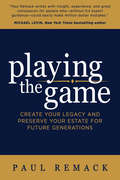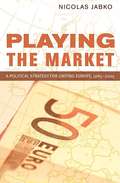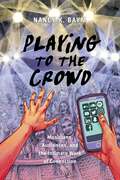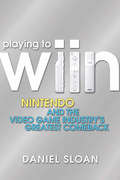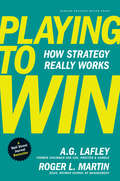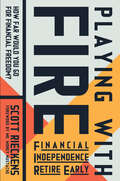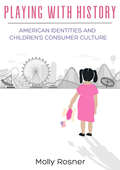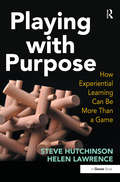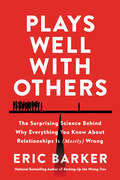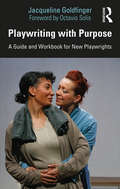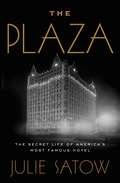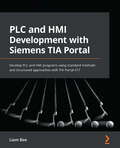- Table View
- List View
Playing the Field: Competing Bids for Anadarko Petroleum Corp
by Benjamin C. Esty Daniel W. Green E. Scott MayfieldAnadarko Petroleum CEO Al Walker must make a recommendation to his board of directors regarding the merits of two competing merger proposals. Weeks earlier, on April 11, 2019, Anadarko had agreed to be acquired by Chevron Corporation in a cash and stock deal that Chevron valued at $65 per Anadarko share. Now, following speculation that Occidental was working with Warren Buffett, Anadarko had received a competing bid from Occidental Petroleum that Occidental valued at $76 per Anadarko share. Walker now needed to decide which offer was superior. If the Anadarko bid was determined to be superior, Anadarko would be required to pay a $1 billion break-up fee to Chevron.
Playing the Game: Create Your Legacy and Preserve Your Estate for Future Generations
by Paul RemackPersonal wealth isn’t the only purpose of hard work and investment; it’s also important to be able to pass wealth on to one’s children and grandchildren. Wealth transfer and distribution is a game, and if played poorly—or if it is not realized a game is being played—one’s fortune can be eaten away by a combination of poor investments and unfair taxation. Written by a financial advisor with decades of experience, Playing the Game prepares people for the game of Wealth Transfer and Distribution, enabling them to pass on their fortune intact so that future generations may enjoy it.
Playing the Market
by Nicolas JabkoIn the 1980s and 1990s, Nicolas Jabko suggests, the character of European integration altered radically, from slow growth to what he terms a "quiet revolution. " In this book he traces the political strategy that underlay the move from the Single Market of 1986 through the official creation of the European Union in 1992 to the coming of the euro in 1999. The official, shared language of the political forces behind this revolution was that of market reforms-yet, as Jabko notes, this was a very strange "market" revolution, one that saw the building of massive new public institutions designed to regulate economic activity, such as the Economic and Monetary Union, and deeper liberalization in economic areas unaffected by external pressure than in truly internationalized sectors of the European economy. What held together this remarkably diverse reform movement? Precisely because "the market" wasn't a single standard, the agenda of market reforms gained the support of a vast and heterogenous coalition. The "market" was in fact a broad palette of ideas to which different actors could appeal under different circumstances. It variously stood for a constraint on government regulations, a norm by which economic activities were (or should be) governed, a space for the active pursuit of economic growth, an excuse to discipline government policies, and a beacon for new public powers and rule-making. In chapters on financial reform, the provision of collective services, regional development and social policy, and economic and monetary union, Jabko traces how a coalition of strange bedfellows mobilized a variety of market ideas to integrate Europe.
Playing to the Crowd: Musicians, Audiences, and the Intimate Work of Connection (Postmillennial Pop #14)
by Nancy K. BaymExplains what happened to music—for both artists and fans—when music went online. Playing to the Crowd explores and explains how the rise of digital communication platforms has transformed artist-fan relationships into something closer to friendship or family. Through in-depth interviews with musicians such as Billy Bragg and Richie Hawtin, as well as members of the Cure, UB40, and Throwing Muses, Baym reveals how new media has facilitated these connections through the active, and often required, participation of the artists and their devoted, digital fan base.Before the rise of social sharing and user-generated content, fans were mostly seen as an undifferentiated and unidentifiable mass, often mediated through record labels and the press. However, in today’s networked era, musicians and fans have built more active relationships through social media, fan sites, and artist sites, giving fans a new sense of intimacy and offering artists unparalleled information about their audiences. However, this comes at a price. For audiences, meeting their heroes can kill the mystique. And for artists, maintaining active relationships with so many people can be both personally and financially draining, as well as extremely labor intensive.Drawing on her own rich history as an active and deeply connected music fan, Baym offers an entirely new approach to media culture, arguing that the work musicians put in to create and maintain these intimate relationships reflect the demands of the gig economy, one which requires resources and strategies that we must all come to recognize and appreciate.
Playing to Wiin
by Daniel SloanHow Nintendo reclaimed its spot at the top of one of the world's most competitive industries Nintendo was once the dominant force in home video gaming--until Sony and Microsoft pummeled them with powerful new consoles. As those two giants battled each other for market share, Nintendo looked dead and buried. Then, true to its secretive, low-profile approach, Nintendo roared back into the market with its revolutionary Wii console and portable Nintendo DS system. Taking a completely different approach to gaming while embracing its creative roots, the company was back at the top of its game. But how did a struggling Japanese family company, with its origins in nineteenth-century playing cards, come to dominate a competitive, high-tech industry? Playing to Wiin details the key succession issue for Nintendo, the development of the DS and Wii consoles, and the creation of remarkable new gaming software. All these factors combined to drive Nintendo back to the top of the gaming world. Reveals the business strategy that led Nintendo back to the top of the gaming industry amidst fierce competition from bigger rivals An inspirational story of a stunning business turnaround and the hyper-creative minds behind it Written by an acclaimed financial and business journalist based in Tokyo Offering a fascinating inside look at a market-leading company once left for dead, Playing to Wiin is a must-read for executives and leaders interested in one of the greatest business turnarounds in history.
Playing to Win: 1. Strategy Is Choice
by A. G. Lafley Roger L. MartinPlay to Win: How Strategy Really Works is an 8-chapter books published in 2013 by Harvard Business Review Press and written by former Procter & Gamble CEO A.G. Lafley and Rotman School of Management Dean Roger L. Martin. The authors present a framework for creating strategy based on a decade of work at P&G. The framework is a strategic choice cascade, made up of 5 decision points that apply to companies of all sizes and in all markets. The model guides leaders in making choices around a winning aspiration, where to play, how to win, core capabilities, and management systems and is enriched by using the context of P&G's experience. The authors provide perspectives on how to put the framework into practice, offering practical tips and personal insights. In Chapter 1, Strategy Is Choice (28 pages), the authors use the story of P&G's revitalization of the Oil of Olay brand to introduce their strategic framework, a "strategic choice cascade" of five questions that help a company develop a shared understanding of its strategy and the plan to achieve it. The authors look at each question in the framework as well as the interaction among them.
Playing to Win: 2. What Is Winning?
by A. G. Lafley Roger L. MartinPlay to Win: How Strategy Really Works is an 8-chapter books published in 2013 by Harvard Business Review Press and written by former Procter & Gamble CEO A.G. Lafley and Rotman School of Management Dean Roger L. Martin. The authors present a framework for creating strategy based on a decade of work at P&G. The framework is a strategic choice cascade, made up of 5 decision points that apply to companies of all sizes and in all markets. The model guides leaders in making choices around a winning aspiration, where to play, how to win, core capabilities, and management systems and is enriched by using the context of P&G's experience. The authors provide perspectives on how to put the framework into practice, offering practical tips and personal insights. Chapter 2, What Is Winning? (16 pages), looks at the first question in the choice cascade about the company's winning aspiration. This aspiration defines the company's purpose and establishes the context for the strategy to follow. The authors emphasize that a successful company focuses on winning -not just participating-to be able to prioritize and commit to the difficult choices that inevitably arise. The authors explore winning aspirations through two real world examples: the GM launch of Saturn and P&G's decision to outsource global business services at the end of the 1990s. The chapter includes an essay, "Strategy as Winning."
Playing to Win: 3. Where to Play
by A. G. Lafley Roger L. MartinPlay to Win: How Strategy Really Works is an 8-chapter books published in 2013 by Harvard Business Review Press and written by former Procter & Gamble CEO A.G. Lafley and Rotman School of Management Dean Roger L. Martin. The authors present a framework for creating strategy based on a decade of work at P&G. The framework is a strategic choice cascade, made up of 5 decision points that apply to companies of all sizes and in all markets. The model guides leaders in making choices around a winning aspiration, where to play, how to win, core capabilities, and management systems and is enriched by using the context of P&G's experience. The authors provide perspectives on how to put the framework into practice, offering practical tips and personal insights. Chapter 3, Where to Play (23 pages), moves to the second step of the framework, making market decisions connected company's winning aspiration. Market choices define the company's business focus and set the stage for the challenges to come. The authors divide these choices into five dimensions: geography, product type, consumer segment, distribution channel, and vertical stage of production. They explain that while these dimensions are the same for all companies, the significance of each dimension is variable, and they illustrate with an analysis of P&G's Bounty brand. The authors also discuss the role of the competitive arena and highlight common problems that companies face in making market decisions. They look in depth at how P&G found new markets for established brands.
Playing to Win: 6. Manage What Matters
by A. G. Lafley Roger L. MartinPlay to Win: How Strategy Really Works is an 8-chapter books published in 2013 by Harvard Business Review Press and written by former Procter & Gamble CEO A.G. Lafley and Rotman School of Management Dean Roger L. Martin. The authors present a framework for creating strategy based on a decade of work at P&G. The framework is a strategic choice cascade, made up of 5 decision points that apply to companies of all sizes and in all markets. The model guides leaders in making choices around a winning aspiration, where to play, how to win, core capabilities, and management systems and is enriched by using the context of P&G's experience. The authors provide perspectives on how to put the framework into practice, offering practical tips and personal insights. Chapter 6, Manage What Matters (29 pages), examines the last step in the model, management systems. The authors argue that successful strategy requires a company's leaders to actively implement and support its strategy with the right processes and systems. This includes implementing systems for creating and reviewing the strategy, creating structures to support the organization's core capabilities, and taking measures to ensure that the strategy is working. The authors look at the importance and role of corporate culture, communication channels, and measurement tools, drawing on a number of approaches and strategies employed by P&G management teams. The chapter includes the essay "Communicating to the Organization."
Playing to Win: 7. Think Through Strategy
by A. G. Lafley Roger L. MartinPlay to Win: How Strategy Really Works is an 8-chapter books published in 2013 by Harvard Business Review Press and written by former Procter & Gamble CEO A.G. Lafley and Rotman School of Management Dean Roger L. Martin. The authors present a framework for creating strategy based on a decade of work at P&G. The framework is a strategic choice cascade, made up of 5 decision points that apply to companies of all sizes and in all markets. The model guides leaders in making choices around a winning aspiration, where to play, how to win, core capabilities, and management systems and is enriched by using the context of P&G's experience. The authors provide perspectives on how to put the framework into practice, offering practical tips and personal insights. In Chapter 7, Think Through Strategy (23 pages), the authors provide guidance on how to organize strategic thinking and synthesize complex data. They offer a framework, called the "strategic logic flow," which identifies four major dimensions for leaders to consider-the industry, the customers, a company's relative position, and the competition-and then present seven questions that systematically evaluate these four dimensions. The strategic logic flow allows management to identify key areas of analysis to generate competitive advantage. The authors explain the seven questions using examples from many of P&G's business units. The chapter includes the essay "The Long Road to the Logic Flow."
Playing to Win: 8. Shorten Your Odds
by A. G. Lafley Roger L. MartinPlay to Win: How Strategy Really Works is an 8-chapter books published in 2013 by Harvard Business Review Press and written by former Procter & Gamble CEO A.G. Lafley and Rotman School of Management Dean Roger L. Martin. The authors present a framework for creating strategy based on a decade of work at P&G. The framework is a strategic choice cascade, made up of 5 decision points that apply to companies of all sizes and in all markets. The model guides leaders in making choices around a winning aspiration, where to play, how to win, core capabilities, and management systems and is enriched by using the context of P&G's experience. The authors provide perspectives on how to put the framework into practice, offering practical tips and personal insights. Chapter 8, Shorten Your Odds (28 pages), explores group decision making and provides practical insight on how to put the strategic choice cascade into practice. The authors critique the traditional approach to generating "buy-in" and offer a process to focus on the critical questions for determining strategy. This process enables leaders to "reverse engineer" the possible outcomes and make informed choices. The authors walk the reader through seven steps from framing a choice and broadening the options, to using a strategic logic flow and testing outcomes. The chapter includes two essays "The Most Important Question In Strategy" and "The Power of an Outside Strategy Partner."
Playing to Win: Conclusion. The Endless Pursuit of Winning
by A. G. Lafley Roger L. MartinPlay to Win: How Strategy Really Works is an 8-chapter books published in 2013 by Harvard Business Review Press and written by former Procter & Gamble CEO A.G. Lafley and Rotman School of Management Dean Roger L. Martin. The authors present a framework for creating strategy based on a decade of work at P&G. The framework is a strategic choice cascade, made up of 5 decision points that apply to companies of all sizes and in all markets. The model guides leaders in making choices around a winning aspiration, where to play, how to win, core capabilities, and management systems and is enriched by using the context of P&G's experience. The authors provide perspectives on how to put the framework into practice, offering practical tips and personal insights. In their Conclusion, The Endless Pursuit of Winning (6 pages), the authors provide a brief recap of their strategic model and offer their perspective on implementing strategy in a changing and volatile world. They outline the common mistakes that companies make in creating a strategy, such as targeting too many customer types, competing in too broad a marketplace, and not choosing a distinctive strategy. They also outline key indicators of a winning strategy, including internal strategic tools and external factors such as customer response and competitor relationships.
Playing to Win: Introduction, How Strategy Really Works
by A. G. Lafley Roger L. MartinPlay to Win: How Strategy Really Works is an 8-chapter books published in 2013 by Harvard Business Review Press and written by former Procter & Gamble CEO A.G. Lafley and Rotman School of Management Dean Roger L. Martin. The authors present a framework for creating strategy based on a decade of work at P&G. The framework is a strategic choice cascade, made up of 5 decision points that apply to companies of all sizes and in all markets. The model guides leaders in making choices around a winning aspiration, where to play, how to win, core capabilities, and management systems and is enriched by using the context of P&G's experience. The authors provide perspectives on how to put the framework into practice, offering practical tips and personal insights. The book's Introduction, How Strategy Really Works (6 pages), lays the foundation by highlighting the central concepts. The authors define strategy as making choices of what to do and what not to do, and explain why this process is essential to understanding and planning for a business. They explain briefly how they developed their framework during their time at P&G, but they also believe that this strategic process applies to companies of all sizes. The chapter ends with a look at common, yet ineffective, ways that leaders tend to approach strategy, thus setting up the arguments presented in the chapters.
Playing to Win
by A. G. Lafley Roger L. MartinThis is A.G. Lafley's guidebook. Shouldn't it be yours as well?Winning CEO A.G. Lafley is now back at the helm of consumer goods giant Procter & Gamble. If you want to know the strategy he'll use to restore P&G to its former dominance-read this book.Playing to Win, a noted Wall Street Journal and Washington Post bestseller, outlines the strategic approach Lafley, in close partnership with strategic adviser Roger Martin, used to double P&G's sales, quadruple its profits, and increase its market value by more than $100 billion when Lafley was first CEO (he led the company from 2000 to 2009). The book shows leaders in any type of organization how to guide everyday actions with larger strategic goals built around the clear, essential elements that determine business success-where to play and how to win.Lafley and Martin have created a set of five essential strategic choices that, when addressed in an integrated way, will move you ahead of your competitors. They are: (1) What is our winning aspiration? (2) Where will we play? (3) How will we win? (4) What capabilities must we have in place to win? and (5) What management systems are required to support our choices? The result is a playbook for winning.The stories of how P&G repeatedly won by applying this method to iconic brands such as Olay, Bounty, Gillette, Swiffer, and Febreze clearly illustrate how deciding on a strategic approach-and then making the right choices to support it-makes the difference between just playing the game and actually winning.Playing to Win outlines a proven method that has worked for some of today's most celebrated brands and products. Let this book serve as your new guide to winning, as well.
Playing with FIRE (Financial Independence Retire Early): How Far Would You Go for Financial Freedom?
by Scott RieckensWhat if a happier life was only a few simple choices away? A successful entrepreneur living in Southern California, Scott Rieckens had built a &“dream life&”: a happy marriage, a two-year-old daughter, a membership to a boat club, and a BMW in the driveway. But underneath the surface, Scott was creatively stifled, depressed, and overworked trying to help pay for his family&’s beach-town lifestyle. Then one day, Scott listened to a podcast interview that changed everything. Five months later, he had quit his job, convinced his family to leave their home, and cut their expenses in half. Follow Scott and his family as they devote everything to FIRE (financial independence retire early), a subculture obsessed with maximizing wealth and happiness. Filled with inspiring case studies and powerful advice, Playing with FIRE is one family&’s journey to acquire the one thing that money can&’t buy: a simpler — and happier — life. Based on the documentary
Playing with History: American Identities and Children’s Consumer Culture
by Molly RosnerSince the advent of the American toy industry, children’s cultural products have attempted to teach and sell ideas of American identity. By examining cultural products geared towards teaching children American history, Playing With History highlights the changes and constancies in depictions of the American story and ideals of citizenship over the last one hundred years. This book examines political and ideological messages sold to children throughout the twentieth century, tracing the messages conveyed by racist toy banks, early governmental interventions meant to protect the toy industry, influences and pressures surrounding Cold War stories of the western frontier, the fractures visible in the American story at a mid-century history themed amusement park. The study culminates in a look at the successes and limitations of the American Girl Company empire.
Playing with Purpose: How Experiential Learning Can Be More Than a Game
by Steve Hutchinson Helen LawrencePlaying with Purpose shows how a facilitator, coach, manager, people developer or trainer can invent or reinvigorate an artificial learning experience and make it so much more than a game. The authors look at a range of dilemmas, challenges and problems faced by anyone wanting to run memorable training sessions, classes and project meetings and then demonstrate how to get powerful lessons from the simplest of household and office objects and situations. The exercises and ideas outlined provide a focused examination of a range of training aims and outcomes including leadership, teamwork, communications, equality and diversity, feedback and personal effectiveness; as well as general energisers, closers and problems to be solved. Steve Hutchinson and Helen Lawrence believe that seeing their sustainable, creative approach to experiential learning explicitly laid out, will give you the confidence to develop your own solutions.
Playmakers: How the NFL Really Works (And Doesn't)
by Mike FlorioThe story of a modern NFL that can&’t get out of its own way—and can&’t stop making moneyIn recent decades, the NFL has simultaneously become an athletic, financial, and cultural powerhouse—and a League that can&’t seem to go more than a few weeks without a scandal. Whether it&’s about domestic violence, performance-enhancing drugs, racism, or head trauma, the NFL always seems to be in some kind of trouble. Yet no matter the drama, the TV networks keep showing games, the revenue keeps rising, and the viewers keep tuning in.How can a sports league—or any organization—operate this way? Why do the negative stories keep happening, and why don&’t they ever seem to affect the bottom line? In this wide-ranging book, Mike Florio takes readers from the boardroom to the locker room, from draft day to the Super Bowl, answering these questions and more, and showing what really goes on in the sport that America can&’t seem to quit.Known for his constant stream of new information and incisive commentary, Florio delivers again in this book. With new insights and reporting on scandals past and present, this book will be the talk of the League—whether the League likes it or not.
Plays Well with Others: The Surprising Science Behind Why Everything You Know About Relationships Is (Mostly) Wrong
by Eric BarkerFrom the author of the Wall Street Journal bestseller Barking Up the Wrong Tree comes a cure-all for our increasing emotional distance and loneliness—a smart, surprising, and thoroughly entertaining guide to help build better friendships, reignite love, and get closer to others, whether you’re an extrovert or introvert, socially adept or socially anxious.Can you judge a book by its cover? Is a friend in need truly a friend indeed? Does love conquer all? Is no man an island? In Plays Well with Others, Eric Barker dives into these age-old maxims drawing on science to reveal the truth beyond the conventional wisdom about human relationships. Combining his compelling storytelling and humor, Barker explains what hostage negotiation techniques and marital arguments have in common, how an expert con-man lied his way into a twenty-year professional soccer career, and why those holding views diametrically opposed to our own actually have the potential to become our closest, most trusted friends.Inside you will learn:The two things essential to making friends – and what Dale Carnegie got wrong.What creates love, reignites love, and sustains love. (There’s no Build-A-Bear store for a happy marriage but this is close.)The ethical and effective way to get your partner to change.How social media can actually improve relationships.The antidote to loneliness and why what we usually hear doesn’t work.And so much more. The book is packed with high-five-worthy stories about the greatest female detective to ever live, the most successful liar to ever open his mouth, genius horses, thieving hermits, the perils of perfect memories, and placebos. Leveraging the best evidence available—free of platitudes or magical thinking—Barker analyzes multiple sides of an issue before rendering his verdict. What he’s uncovered is surprising, counterintuitive, and timely—and will change the way you interact in the world and with those around you just when you need it most.
Playwriting in Europe: Mapping Ecosystems and Practices with Fabulamundi (Routledge Advances in Theatre & Performance Studies)
by Margherita LaeraThis book maps contemporary playwriting and theatre translation practices and ecologies in the European continent. Whether you are a scholar researching contemporary drama and translation, or a theatre practitioner looking for ways to navigate theatrical conventions in other countries, this book is for you. Through questionnaires and one-to-one interviews with key stakeholders, Dr Laera collects qualitative and quantitative data about how each national theatre culture supports living dramatists, what conventions drive the production and translation (or lack thereof) of contemporary plays, and what perceptions are held by gatekeepers, theatre-makers and other cultural operators about the theatre system in which they work. Through country-by-country descriptions and analyses; interviews with playwrights, translators, directors and gatekeepers; a list of key facts and best practices; and a rigorous assessment of its methodologies, this volume is indispensable for those interested in contemporary European theatre practice.
Playwriting with Purpose: A Guide and Workbook for New Playwrights
by Jacqueline GoldfingerPlaywriting with Purpose: A Guide and Workbook for New Playwrights provides a holistic approach to playwriting from an award-winning playwright and instructor. This book incorporates craft lessons by contemporary playwrights and provides concrete guidance for new and emerging playwrights. The author takes readers through the entire creative process, from creating characters and writing dialogue and silent moments to analyzing elements of well-made plays and creating an atmospheric environment. Each chapter is followed by writing prompts and pro tips that address unique facets of the conversation about the art and craft of playwriting. The book also includes information on the business of playwriting and a recommended reading list of published classic and contemporary plays, providing all the tools to successfully transform an idea into a script, and a script into a performance. Playwriting with Purpose gives writers and students of playwriting hands-on lessons, artistic concepts, and business savvy to succeed in today’s theater industry.
The Plaza: The Secret Life of America's Most Famous Hotel
by Julie SatowJournalist Julie Satow's thrilling, unforgettable history of how one illustrious hotel has defined our understanding of money and glamour, from the Gilded Age to the Go-Go Eighties to today's Billionaire Row. p.p1 {margin: 0.0px 0.0px 0.0px 0.0px; font: 12.0px Arial} p.p2 {margin: 0.0px 0.0px 0.0px 0.0px; text-indent: 36.0px; font: 12.0px Arial} From the moment in 1907 when New York millionaire Alfred Gwynne Vanderbilt strode through the Plaza Hotel's revolving doors to become its first guest, to the afternoon in 2007 when a mysterious Russian oligarch paid a record price for the hotel's largest penthouse, the eighteen-story white marble edifice at the corner of Fifth Avenue and 59th Street has radiated wealth and luxury. For some, the hotel evokes images of F. Scott Fitzgerald frolicking in the Pulitzer Fountain, or Eloise, the impish young guest who pours water down the mail chute. But the true stories captured in THE PLAZA also include dark, hidden secrets: the cold-blooded murder perpetrated by the construction workers in charge of building the hotel, how Donald J. Trump came to be the only owner to ever bankrupt the Plaza, and the tale of the disgraced Indian tycoon who ran the hotel from a maximum-security prison cell, 7,000 miles away in Delhi. In this definitive history, award-winning journalist Julie Satow not only pulls back the curtain on Truman Capote's Black and White Ball and The Beatles' first stateside visit-she also follows the money trail. THE PLAZA reveals how a handful of rich, dowager widows were the financial lifeline that saved the hotel during the Great Depression, and how, today, foreign money and anonymous shell companies have transformed iconic guest rooms into condominiums that shield ill-gotten gains-hollowing out parts of the hotel as well as the city around it.THE PLAZA is the account of one vaunted New York City address that has become synonymous with wealth and scandal, opportunity and tragedy. With glamour on the surface and strife behind the scenes, it is the story of how one hotel became a mirror reflecting New York's place at the center of the country's cultural narrative for over a century.
Plaza, the Logistics Park of Zaragoza
by Noel Watson Santiago KraiselburdIn the year 2000, the Government of the Autonomous Community of Arag n, Spain, made public a project for the development of a large-scale logistics park in the outskirts of the city of Zaragoza. With an area of nearly 13 square kilometers, PLAZA (an acronym for Zaragoza Logistics Platform) would be by far the largest logistics park either built or under development in all of Europe. This case illustrates the motivations behind such an undertaking, the reasoning used in deciding the feasibility of the location of the park, and also the advantages (and disadvantages) related to the project. The case provides sufficient data to prepare an analysis from the point of view of a potential customer, where the cost advantage or disadvantage of locating a facility in Zaragoza (with respect to Rotterdam, a preferred European location) can be quantified, and where the parameters can be changed to determine the main drivers behind such a decision, and how changes in these drivers can affect the customer's analysis. The results are meant to serve as input for PLAZA management to understand which types of customers to target, and how to address the issues that could hinder the park's projected growth.
PLC and HMI Development with Siemens TIA Portal: Develop PLC and HMI programs using standard methods and structured approaches with TIA Portal V17
by Liam BeeBecome well-versed with the tools available in the Siemens TIA toolbox and write PLC and HMI code effectivelyKey FeaturesFind out how to use TIA Portal effectively to boost your productivityLearn about a structured design pattern and understand why it is so powerful when implemented correctlyDiscover efficient project management and design practicesBook DescriptionWith automation requirements on the rise, Siemens' TIA Portal development environment is almost a necessity for any automation engineer. The Totally Integrated Automation (TIA) environment helps seamlessly integrate all things automation, from PLC hardware and software design to HMI development. This book helps you understand the tools available in the TIA toolbox and shows you how to write code effectively.The book begins by introducing you to the TIA environment, covering the layout and tools available. Once you've got to grips with the environment, you'll find out how to create hardware to write programs against, including adding IO modules and assigning memory for input and output. Next, you'll develop logic in all of the languages that TIA Portal offers, such as Ladder, Function Block Diagram, and Structured Text (SCL) (note that Statement List is not covered as a deprecated language), as well as the newest language, Cause and Effect (CEM). You'll also discover how to store standard code in libraries, creating a version control system that is easy to manage and aids standard design. Finally, following the PLC design chapters, you'll learn how to develop HMI applications in TIA Portal's latest unified hardware.By the end of the book, you'll be well equipped to use all of the features that TIA Portal V17 offers.What you will learnSet up a Siemens Environment with TIA PortalFind out how to structure a projectCarry out the simulation of a project, enhancing this further with structureDevelop HMI screens that interact with PLC dataMake the best use of all available languagesLeverage TIA Portal's tools to manage the deployment and modification of projectsWho this book is forThis TIA Portal book is for anybody looking to learn PLC/HMI development using the latest Siemens development platform. Industrial software engineers, PLC engineers, automation engineers, and electricians will be able to advance their skill set with this guide. A basic understanding of PLC principles such as PLC data types and basic objects such as function blocks and functions is necessary to get started.
The Plea: His client is innocent. His wife is guilty. (Eddie Flynn Series)
by Steve CavanaghFraud. Blackmail. Murder. It's all in a day's work for Eddie Flynn.For years, major New York law firm Harland & Sinton has operated a massive global fraud. The FBI are on to them, but they need witnesses to secure their case. When a major client of the firm, David Child, is arrested for murder, the FBI ask con-artist-turned-lawyer Eddie Flynn to secure Child as his client and force him to testify against the firm.Eddie's not a man to be forced into representing a guilty client, but the FBI have incriminating files on Eddie's wife, Christine, and if Eddie won't play ball, she'll pay the price.When Eddie meets David Child he knows Child is innocent, despite the overwhelming evidence against him. With the FBI putting pressure on him to secure the plea, Eddie must find a way to prove Child's innocence while keeping his wife out of danger - not just from the FBI, but from the firm itself.(p) 2016 Isis Publishing Ltd

